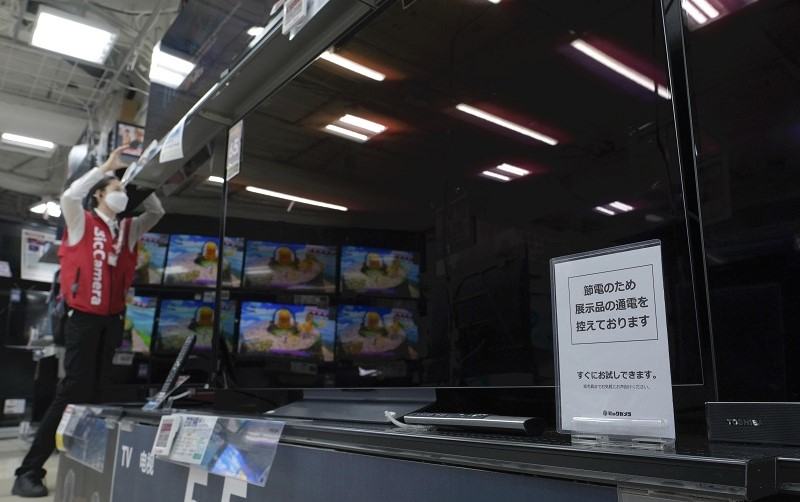
Some TV sets at an electronics store in Shinjuku Ward, Tokyo, are turned off to save electricity on Monday afternoon due to the issuance of a power crunch advisory.
6:00 JST, June 29, 2022
The electricity supply is tight and there are no signs the imbalance with demand for power will be resolved anytime soon. The underlying reasons for this situation are the suspension or abolishment of unprofitable thermal power plants and the delayed restart of nuclear power plants.
The biggest reason, however, is the unusually hot weather for June.
On Monday, the maximum peak electricity demand reached about 52,700 megawatts. That was the highest recorded in June since the 2011 Great East Japan Earthquake, besting the mark set in 2018 of 47,300 megawatts. The increase of nearly 5,400 megawatts is on par with the electricity generated by five nuclear reactors.
Usually, electricity demand increases greatly in July, so some thermal and other power plants are currently undergoing regular inspections, which is another reason for the declining supply capacity.
The earthquake off Fukushima this March is among the reasons that operations have been suspended at the No. 1 and No. 2 thermal power units of the Shinchi Power Station in Shinchi, Fukushima Prefecture. The No. 1 unit has an output of 1,000 megawatts and is set to resume operations at the end of December, while unit 2 also has an output of 1,000 megawatts and is scheduled to be back online at the end of March 2023.
Changing energy mix
A combination of unfavorable conditions has led the central government to issue the first power crunch advisory, but the electricity shortage also has its basis in structural issues.
As more renewable energy sources have been introduced and the power industry has become deregulated, electric power companies have suspended investment in increasingly loss-making thermal power generation. The supply capacity of thermal power generation has been declining year after year. In fiscal 2020, operations were suspended at facilities totaling 16,000 megawatts of output.
While electricity generated from solar power has surged, it is greatly influenced by weather conditions. As for batteries to store electricity from renewable sources, technological development and establishment of necessary facilities have been slow, so this has not helped to alleviate the supply-demand imbalance sufficiently.
Nuclear power plants are seen as stable power sources, but these are slow to restart. Since the 2011 disaster, reactors at just six nuclear power plants have resumed operations and all are located in western Japan, further exacerbating the tight supply-demand situation in eastern Japan.
Issues
The Economy, Trade and Industry Ministry and electric power companies are speeding up efforts to address the supply-demand imbalance.
JERA Co., a 50-50 joint venture of Tokyo Electric Power Company Holdings, Inc. (TEPCO) and Chubu Electric Power Co., is to restart operations of the No. 5 power unit with output of 600 megawatts at the aging Anegasaki Thermal Power Station in Ichihara, Chiba Prefecture, on Wednesday. From July, the company is expected to restart other thermal power stations that are currently under regular inspections one by one.
The economy ministry says that it will be possible to secure a power supply capacity with a reserve margin of 3%, which is said to be the minimum ratio required for stable supply of electricity.
Even so, it is still unclear whether it is possible to stably supply electricity. In the summer of 2021, the maximum peak electricity demand in areas covered by TEPCO and three other power companies exceeded the ministry’s forecast. If demand exceeds forecast, it could become difficult to stably supply electricity. There is also concern over any troubles in restarting aging thermal power units.
There are many issues regarding medium- and long-term measures to address the supply-demand imbalance.
The total capacity of facilities to transmit electricity between eastern and western Japan is now 2,100 megawatts, 900 megawatts larger than the level before the 2011 disaster. The capacity is planned to be increased to 3,000 megawatts in total by the end of fiscal 2027. While there are calls for further increasing the capacity, there is an issue over who will shoulder the huge cost burden of enhancing the power grid system.
If nuclear reactors No. 6 and No. 7 of TEPCO’s Kashiwazaki-Kariwa nuclear power plant in Niigata Prefecture are restarted, about 2,700 megawatts of electricity can be secured. These reactors are not expected to be operating in the foreseeable future, however, as people in the vicinity of the plant have not approved their restart due to a series of scandals.
"Society" POPULAR ARTICLE
-

M4.9 Earthquake Hits Tokyo, Neighboring Prefectures
-

Israeli Tourists Refused Accommodation at Hotel in Japan’s Nagano Pref., Prompting Protest by Israeli Embassy and Probe by Prefecture
-

M7.5 Earthquake Hits Northern Japan; Tsunami Waves Observed in Hokkaido, Aomori and Iwate Prefectures
-

Tsukiji Market Urges Tourists to Avoid Visiting in Year-End
-

High School in Kyoto Says Students Shoplifted during Recent School Trip to Bali, Indonesia
JN ACCESS RANKING
-

Tokyo Economic Security Forum to Hold Inaugural Meeting Amid Tense Global Environment
-

Keidanren Chairman Yoshinobu Tsutsui Visits Kashiwazaki-Kariwa Nuclear Power Plant; Inspects New Emergency Safety System
-

Imports of Rare Earths from China Facing Delays, May Be Caused by Deterioration of Japan-China Relations
-

University of Tokyo Professor Discusses Japanese Economic Security in Interview Ahead of Forum
-

Japan Pulls out of Vietnam Nuclear Project, Complicating Hanoi’s Power Plans























